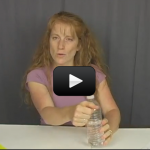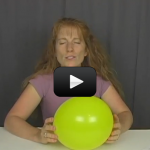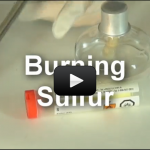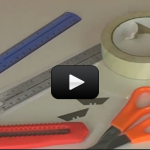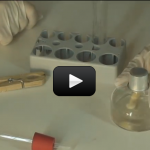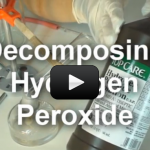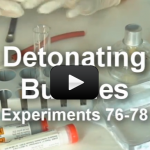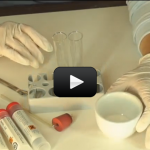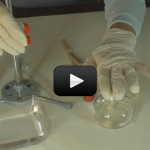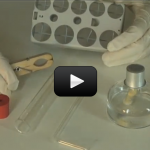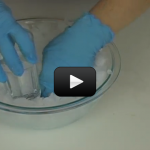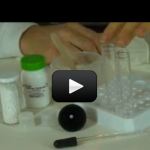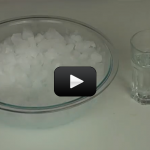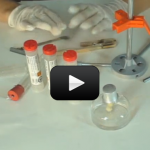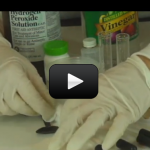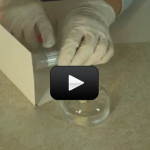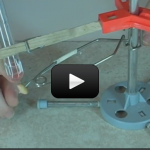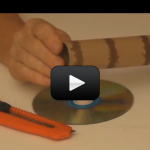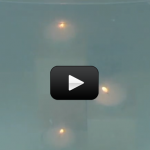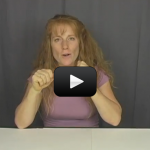States of Matter
There are three primary states of matter: solid, liquid, and gas. Solids are the lowest energy form of matter on Earth. Solids are generally tightly packed molecules that are held together in such a way that they can not change their position. The atoms in a solid can wiggle and jiggle (vibrate) but they can … Continue reading "States of Matter" |
Ideal Gas Law
Pure substances all behave about the same when they are gases. The Ideal Gas Law relates temperature, pressure, and volume of these gases in one simple statement: PV = nRT where P = pressure, V = volume, T = temperature, n = number of moles, and R is a constant. When temperature increases, pressure and … Continue reading "Ideal Gas Law" |
Burning Sulfur
This experiment is for advanced students. Brimstone is another name for sulfur, and if you’ve ever smelled it burn…..whoa….I’m telling you ….you will see for yourself in this lab. It is quite a smell, for sure. Sulfur is element #16 on the periodic table. Sulfur is used in fertilizer, black powder, matches, and insecticides. In … Continue reading "Burning Sulfur" |
Calibrated Spectrometer
Ever play with a prism? When sunlight strikes the prism, it gets split into a rainbow of colors. Prisms un-mix the light into its different wavelengths (which you see as different colors). Diffraction gratings are tiny prisms stacked together. When light passes through a diffraction grating, it splits (diffracts) the light into several beams traveling … Continue reading "Calibrated Spectrometer" |
Can Fish Drown?
If you’ve ever owned a fish tank, you know that you need a filter with a pump. Other than cleaning out the fish poop, why else do you need a filter? (Hint: think about a glass of water next to your bed. Does it taste different the next day?) There are tiny air bubbles trapped … Continue reading "Can Fish Drown?" |
Decomposing Hydrogen Peroxide
This experiment below is for advanced students. If you’ve ever wondered why hydrogen peroxide comes in dark bottles, it’s because the liquid reacts with sunlight to decompose from H2O2 (hydrogen peroxide) into H2O (water) and O2 (oxygen). If you uncap the bottle and wait long enough, you’ll eventually get a container of water (although this … Continue reading "Decomposing Hydrogen Peroxide" |
Detonating Bubbles
This experiment is for advanced students. Zinc (Zn), is a metal and it is found as element #30 on the periodic table. We need a little zinc to keep our bodies balanced, but too much is very dangerous. Zinc is just like the common, everyday substance that we all know as di-hydrogen monoxide (which is … Continue reading "Detonating Bubbles" |
Energy from Sugar
This experiment is for advanced students. Purple and white colors, making the whitewash that Tom Sawyer used, and produce an exothermic chemical reaction…..does it get any better? Limewater is one of the compounds we work with in this experiment. Limewater was used in the old days of America. We’re talking about the 80’s…..the 1880’s. Traveling … Continue reading "Energy from Sugar" |
Ferrofluid
A ferrofluid becomes strongly magnetized when placed in a magnetic field. This liquid is made up of very tiny (10 nanometers or less) particles coated with anti-clumping surfactants and then mixed with water (or solvents). These particles don’t “settle out” but rather remain suspended in the fluid. The particles themselves are made up of either … Continue reading "Ferrofluid" |
Generating Oxygen
This experiment is for advanced students. This time we’re going to use a lot of equipment… really break out all the chemistry stuff. We’ll need all this stuff to generate oxygen with potassium permanganate (KMNO4). We will work with this toxic chemical and we will be careful…won’t we? |
Getting Air from Water
This experiment is for advanced students. This is a repeat of the experiment: Can Fish Drown? but now we’re going to do this experiment again with your new chemistry glassware. The aquarium looked normal in every way, except for the fish. They were breathing very fast and sinking head first to the bottom of the … Continue reading "Getting Air from Water" |
Hot Ice Sculptures
Did you know that supercooled liquids need to heat up in order to freeze into a solid? It’s totally backwards, I know…but it’s true! Here’s the deal: A supercooled liquid is a liquid that you slowly and carefully bring down the temperature below the normal freezing point and still have it be a liquid. We … Continue reading "Hot Ice Sculptures" |
Hot Liquids and Cool Solids
Dissolving calcium chloride is highly exothermic, meaning that it gives off a lot of heat when mixed with water (the water can reach up to 140oF, so watch your hands!). The energy released comes from the bond energy of the calcium chloride atoms, and is actually electromagnetic energy.When you combine the calcium chloride and sodium … Continue reading "Hot Liquids and Cool Solids" |
Instant Ice
Supercooling a liquid is a really neat way of keeping the liquid a liquid below the freezing temperature. Normally, when you decrease the temperature of water below 32oF, it turns into ice. But if you do it gently and slowly enough, it will stay a liquid, albeit a really cold one! In nature, you’ll find … Continue reading "Instant Ice" |
Iodine
This experiment is for advanced students. In gas form, element #59 is deadly. However, when iodine is in liquid form, it helps heal cuts and scrapes. The iodine molecule occurs in pairs, not as a single atom (many halogens do this, and it’s called a diatomic molecule). It’s hard to find iodine in nature, though … Continue reading "Iodine" |
Iodine Clock Reaction
First discovered in 1886 by Hans Heinrich Landolt, the iodine clock reaction is one of the best classical chemical kinetics experiments. Here’s what to expect: Two clear solutions are mixed. At first there is no visible reaction, but after a short time, the liquid suddenly turns dark blue. Usually, this reaction uses a solution of … Continue reading "Iodine Clock Reaction" |
Iodine Rainbow
This is the experiment that your audience will remember from your chemistry magic show. Here's what happens - you call up six 'helpers' and hand each a seemingly empty test tube. Into each test tube, pour a little of the main gold-colored solution, say a few magic words, and their test tubes turn clear, black, … Continue reading "Iodine Rainbow" |
Iron Sparklers
This experiment is for advanced students. Sparks flying off in all directions…that’s fun. In this lab, we will show how easy it is to produce those shooting sparks. In a sparkler you buy at the store, the filings used are either iron or aluminum. The filings are placed in a mixture that, when dry, adheres … Continue reading "Iron Sparklers" |
Peanut Energy
This experiment is for advanced students. Did you know that eating a single peanut will power your brain for 30 minutes? The energy in a peanut also produces a large amount of energy when burned in a flame, which can be used to boil water and measure energy. Peanuts are part of the bean family, … Continue reading "Peanut Energy" |
Spectrometer
Spectrometers are used in chemistry and astronomy to measure light. In astronomy, we can find out about distant stars without ever traveling to them, because we can split the incoming light from the stars into their colors (or energies) and “read” what they are made up of (what gases they are burning) and thus determine … Continue reading "Spectrometer" |
Stairstep Candles
Fire is a chemical reaction (combustion) involving hot gases and plasma. The three things you need for a flame are oxygen, fuel, and a spark. When the fuel (gaseous wax) and oxygen (from the air) combine in a flame, one of the gases produced is carbon dioxide. Most people think of carbon dioxide as dry … Continue reading "Stairstep Candles" |
Mass is Conserved
A fundamental concept in science is that mass is always conserved. Mass is a measure of how much matter (how many atoms) make up an object. Mass cannot be created or destroyed, it can only change form. Materials: paper, lighter or matches with adult help |

